Learn how to make a delicious and easy prime rib roast with just three ingredients: beef rib roast, salt, and pepper. This foolproof recipe will show you how to cook the meat to your desired doneness and get a flavor-popping golden crust every single time.

Table of Contents
An easy and fool-proof prime rib!
A prime rib roast is pricey, so you certainly don’t want to mess it up—especially if you’re trying to razzle-dazzle your boss, in-laws, or guests with a big, honkin‘ piece of meat.
My recommendation? Use the recipe from page 148 of our yellow cookbook, Ready or Not! It’s a mash-up of the best prime rib recipes from two of my favorite and most trusted cooking resources, J. Kenji Lopez-Alt and the nerds at America’s Test Kitchen, and it produces perfect prime rib every time.

Simple and slow does the trick!
With this slow-roasted, reverse sear prime rib recipe, all you need to get a flavor-packed and juicy beef prime rib roast is a nice hunk of beef, time, a good meat thermometer, salt, and pepper. I know there are many recipes out there that include lots of herbs like fresh rosemary or thyme, tons of garlic cloves, mustard, etc. but you won’t need any of it—I promise! With a little advance planning, it’ll be your show-stopping entrée at your Christmas dinner or other holiday feast.
Tips on how to make the best standing rib roast
- Get a good meat thermometer! Even though this recipe is easy-peasy and you’re roasting the meat at a low temp for a long time, you do need an accurate meat thermometer to check that the roast is cooked perfectly. I use both an in-oven thermometer so I can monitor the temperature as the roast is cooking and an instant-read thermometer to double-check the temp.
- Buy a bone-in, but cut out the bones! This ensures great flavor and ease of slicing because you can season the roast all over and carve it easily when it’s done. You can have your butcher cut out the bones or use a sharp boning knife to remove it yourself.
- Season the roast liberally with salt! If you want a well-seasoned and juicy roast, you need to salt it well and dry-brine it for at least 24 hours and up to 4 days. This way the salt will penetrate the meat properly and it will taste amazing!
- Take your time! Plan ahead and dry-brine the roast for at least a day and then allot 4 to 5 hours to slow roast the prime rib at 250°F. Low and slow will cook it evenly!
- Blast the crust! After the slow roast, blast the roast with a quick hit of heat to brown the crust. I like to err on the side of not browning too much because I want the interior to be the perfect temperature (which in my opinion is medium rare).
Required kitchen tools
- Roasting pan and rack
- Kitchen twine
- Instant read meat thermometer and/or in-oven meat thermometer
- Cutting board
- Boning knife
- Carving knife
Ingredients
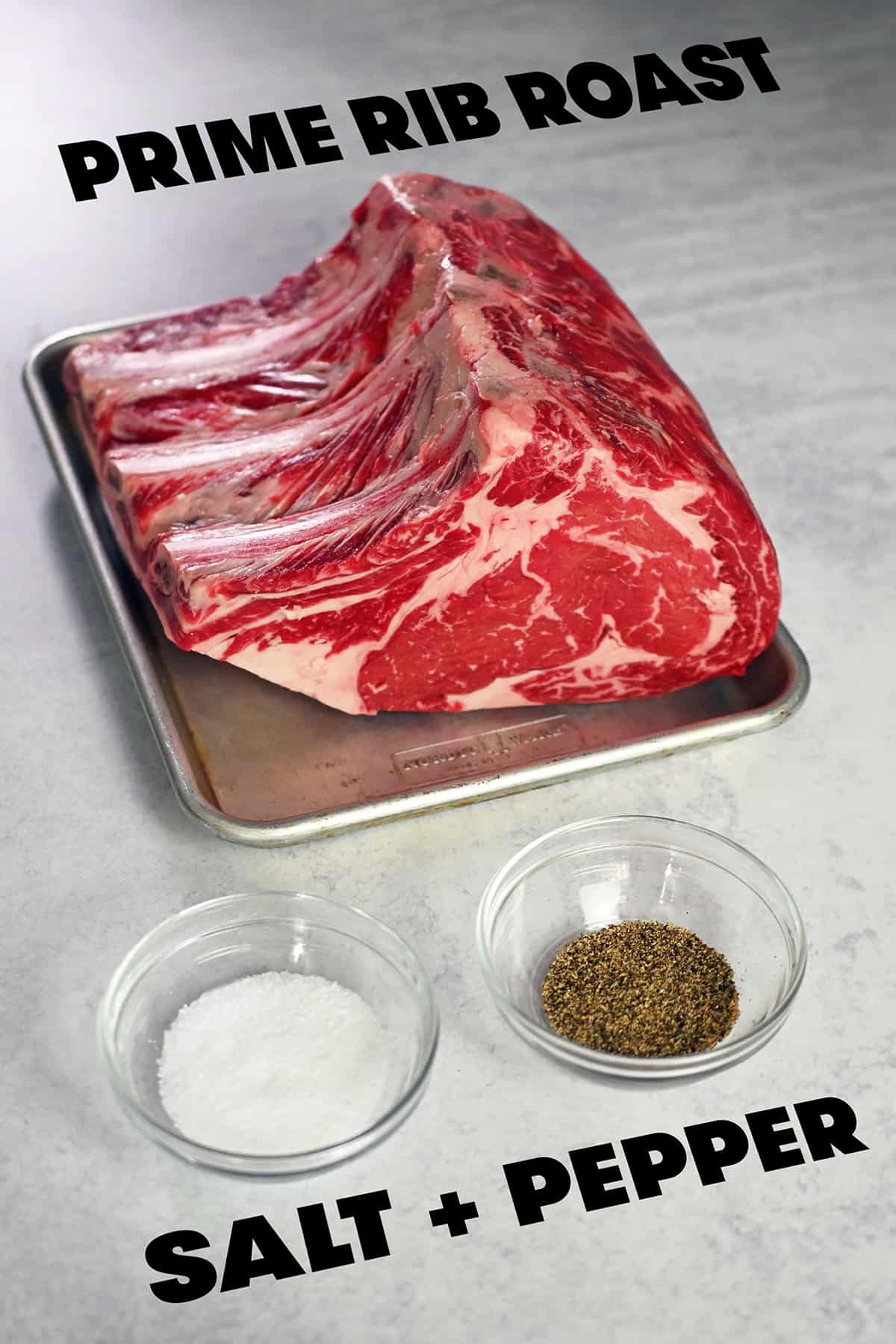
- 1 (9-pound) bone-in prime rib roast: I buy my rib roast from a trusted butcher, but you can also get a great deal on prime grade rib roasts at Costco. A 9-pound bone-in roast feeds about 8 to 10 people generously (about 1 pound per person).
- Diamond Crystal brand kosher salt: I use about ¾ teaspoon Diamond Crystal kosher salt per pound of roast, but it’s hard to over-season a prime rib so don’t skimp on the salt.
- Freshly ground black pepper: The amount of black pepper is up to you, but I use about a quarter of the amount of salt.
How to cook prime rib
Using a sharp knife, cut the bones off the rib roast (or better yet, have your butcher do this for you). Set the bones aside.
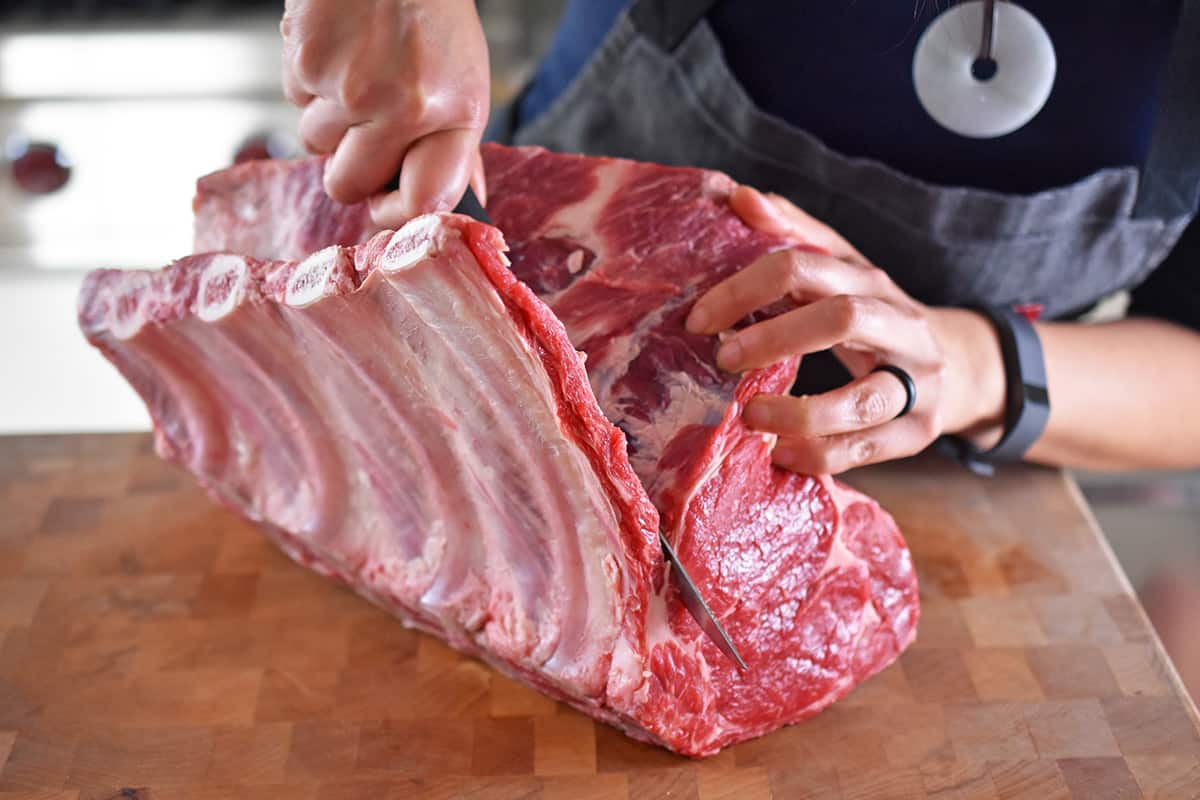
In a small bowl, measure out about ¾ teaspoon Diamond Crystal kosher salt per pound of meat, and mix in freshly ground black pepper.
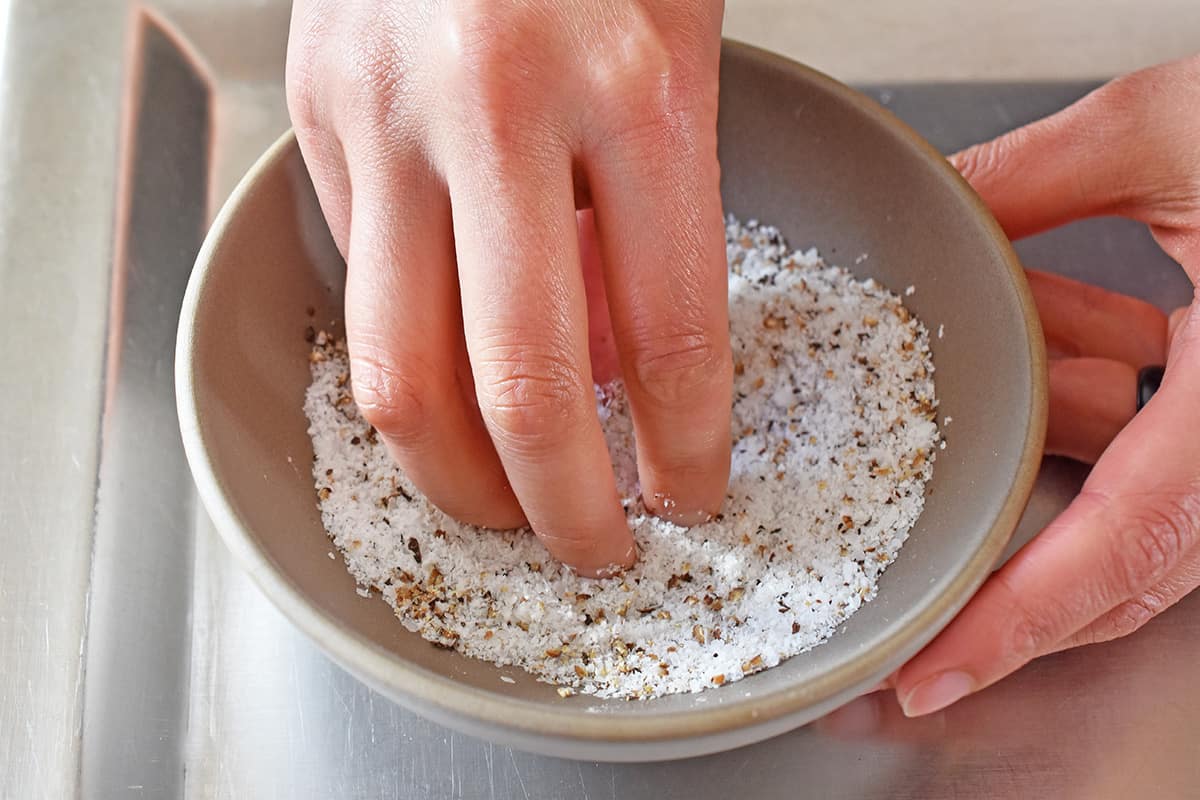
Sprinkle the salt and pepper mixture on all sides of the now-boneless ribeye roast and the rib rack as well. Season generously, people!

Place the seasoned roast back on top of the bones, with the fat cap facing up.
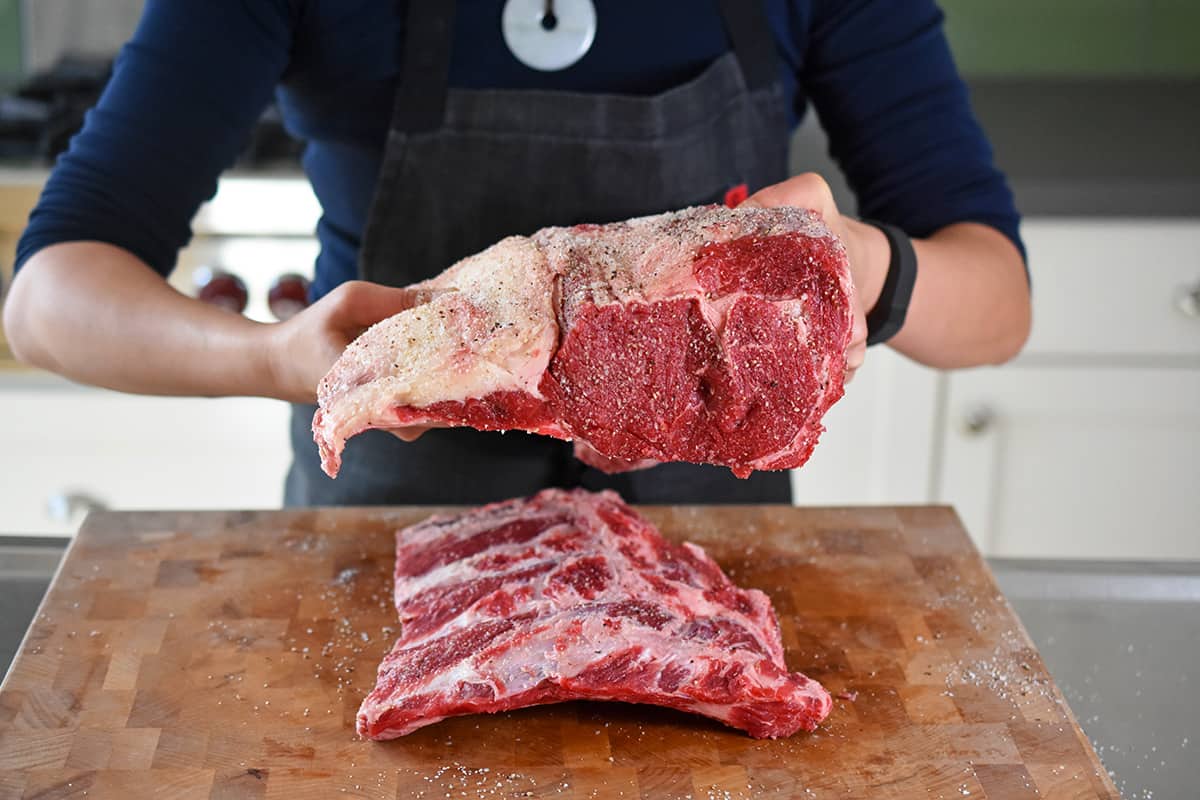
Tie the bones to the roast with kitchen twine and place the prepared roast in a rimmed baking sheet.
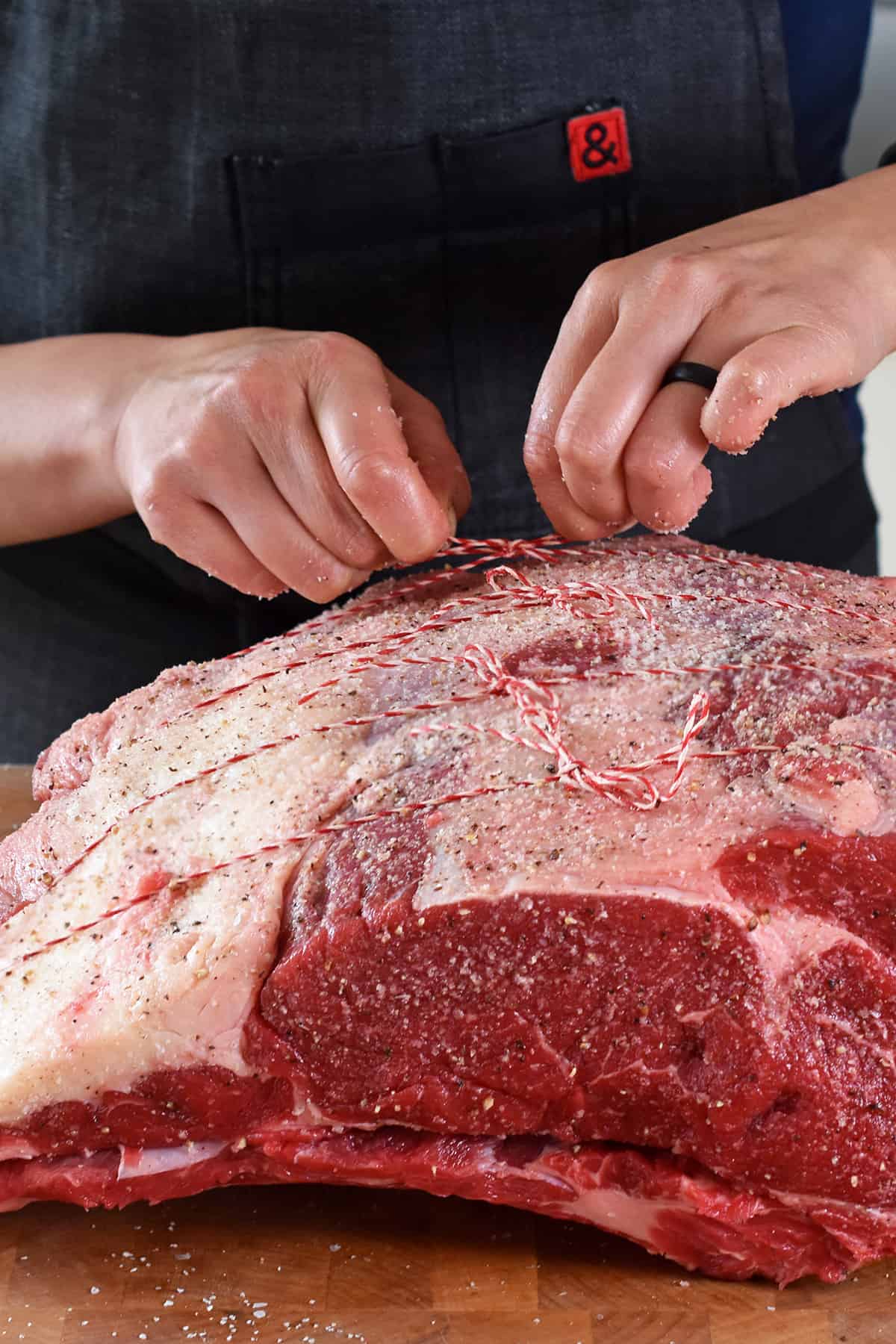
Leave the roast uncovered in your fridge for at least 1 day and up to 4 days. The pre-salting and air-drying will ensure a delicious roast with a browned, beefy crust.
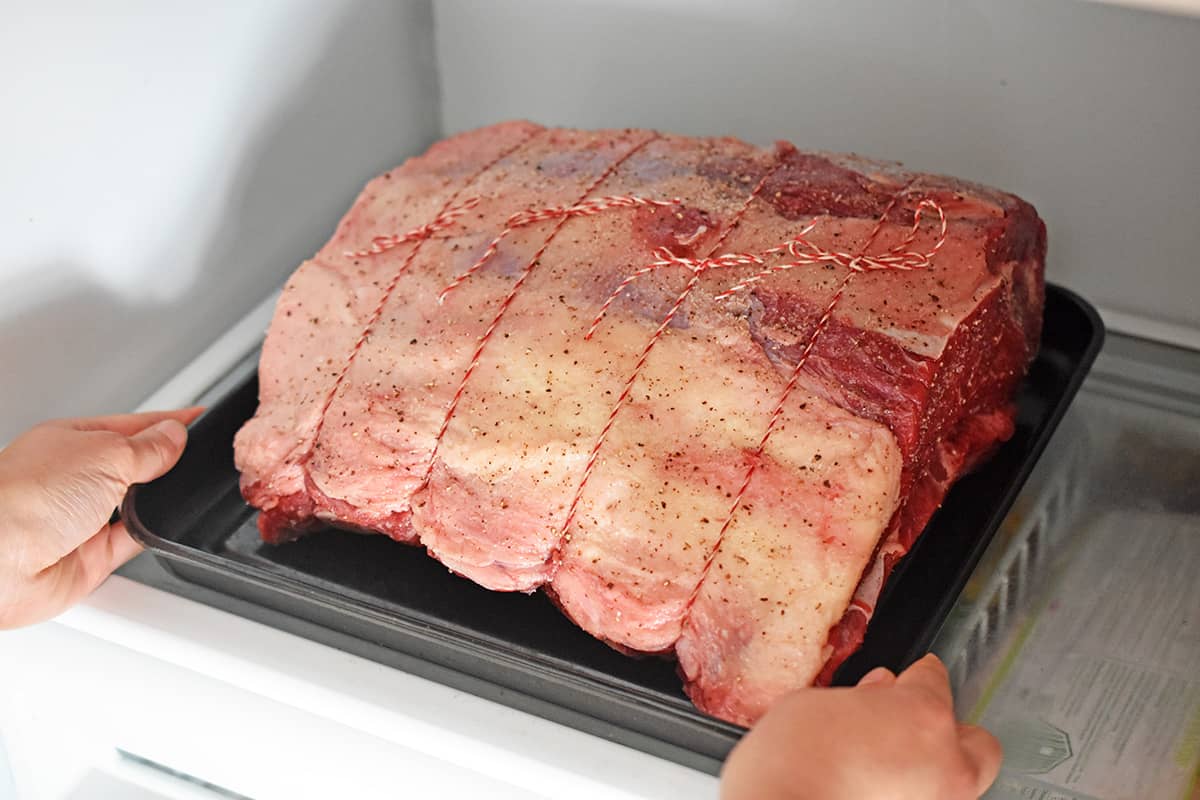
Take your meat out of the fridge and keep at room temp for about 3 hours before you plan to cook the prime rib. Heat the oven to 250°F with the rack in the lower middle position.
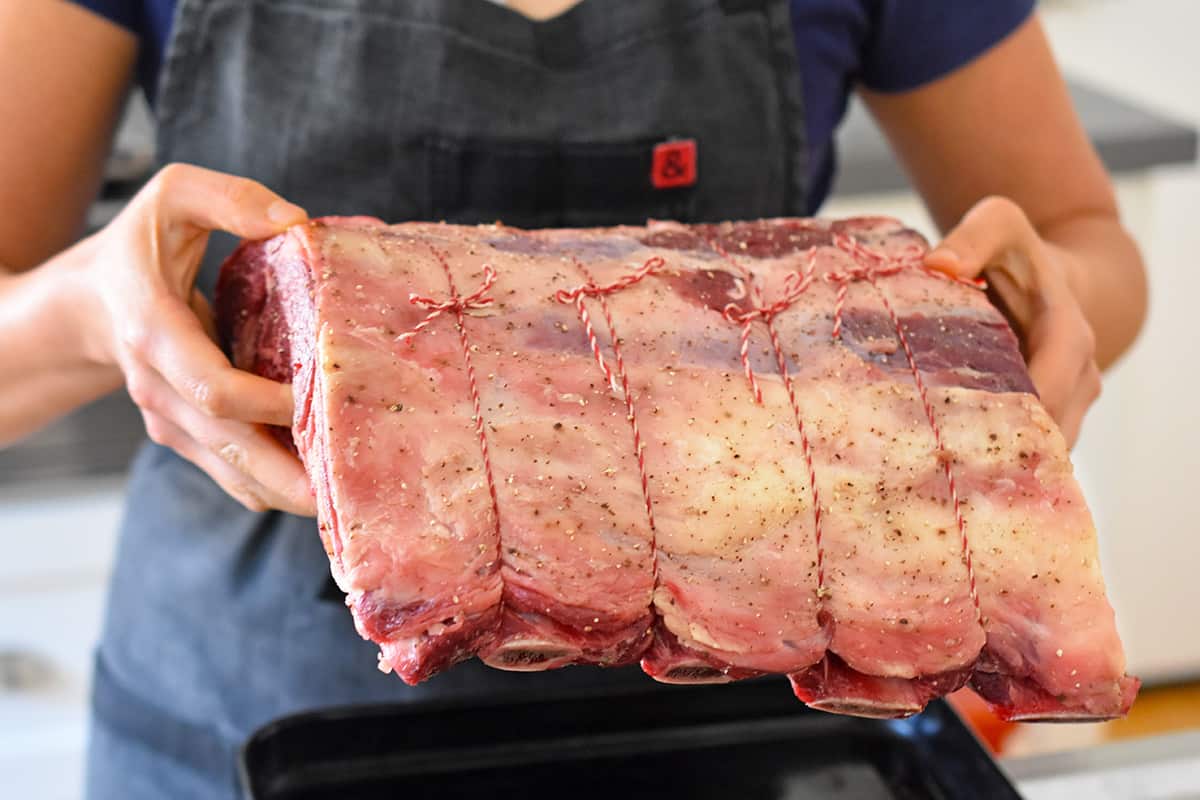
Place the seasoned rib roast on a greased roasting rack in a roasting tray.
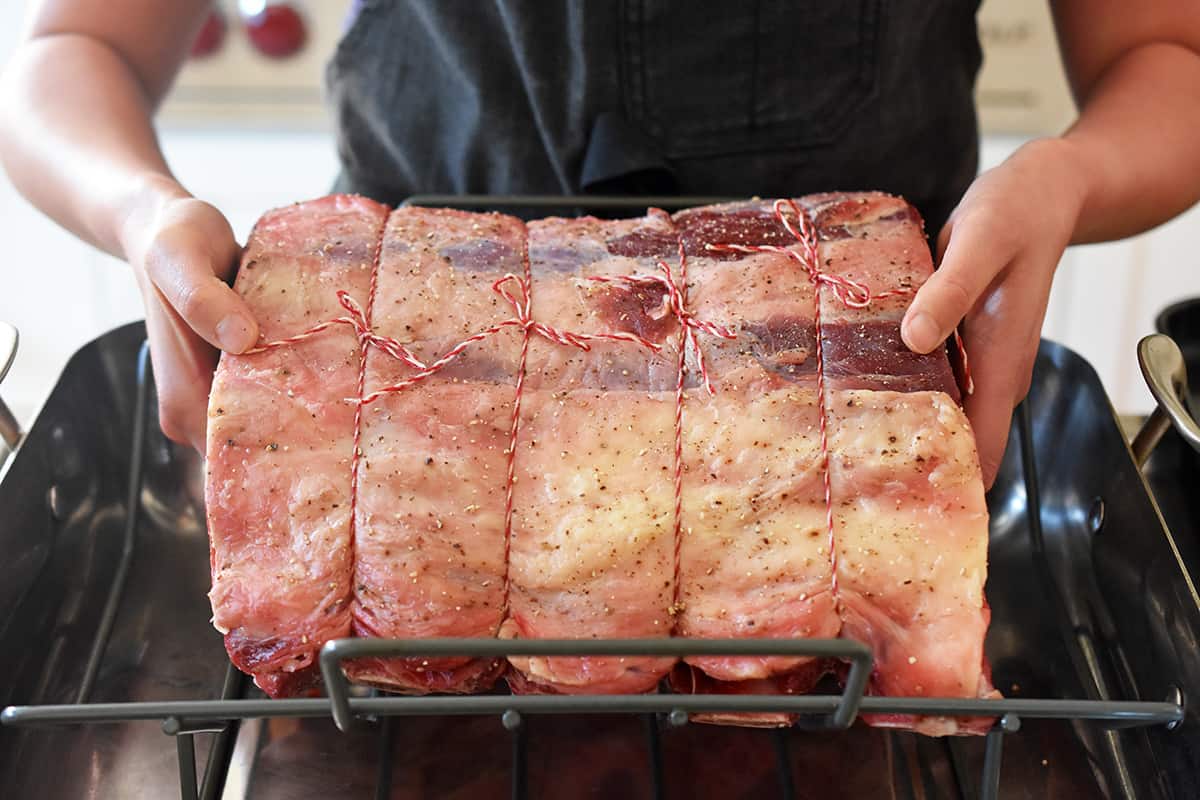
Cook for 4 to 5 hours or until the internal temperature in the thickest part of the roast is 125-130°F for medium-rare prime rib, or 135-140°F for medium.
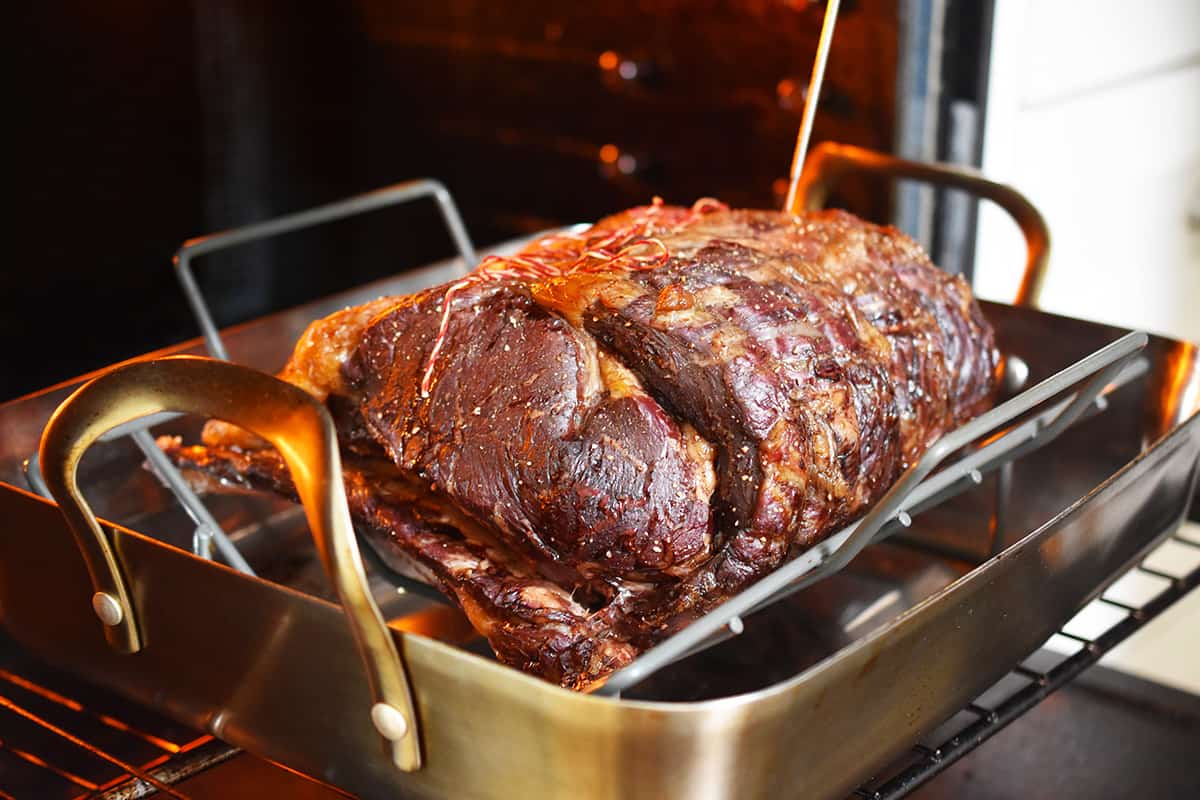
Take out the roast and tent it with foil. Crank the oven to the highest possible temperature it will accommodate (typically 500-550°F). You can also turn on the broiler. We want it HOT!

Remove the foil and put the roast back in the oven, and cook for 5-10 minutes or until the exterior is crisp and well-browned (but not burnt!). There’s a fine line between browning the exterior and cooking the interior of the prime rib too much!
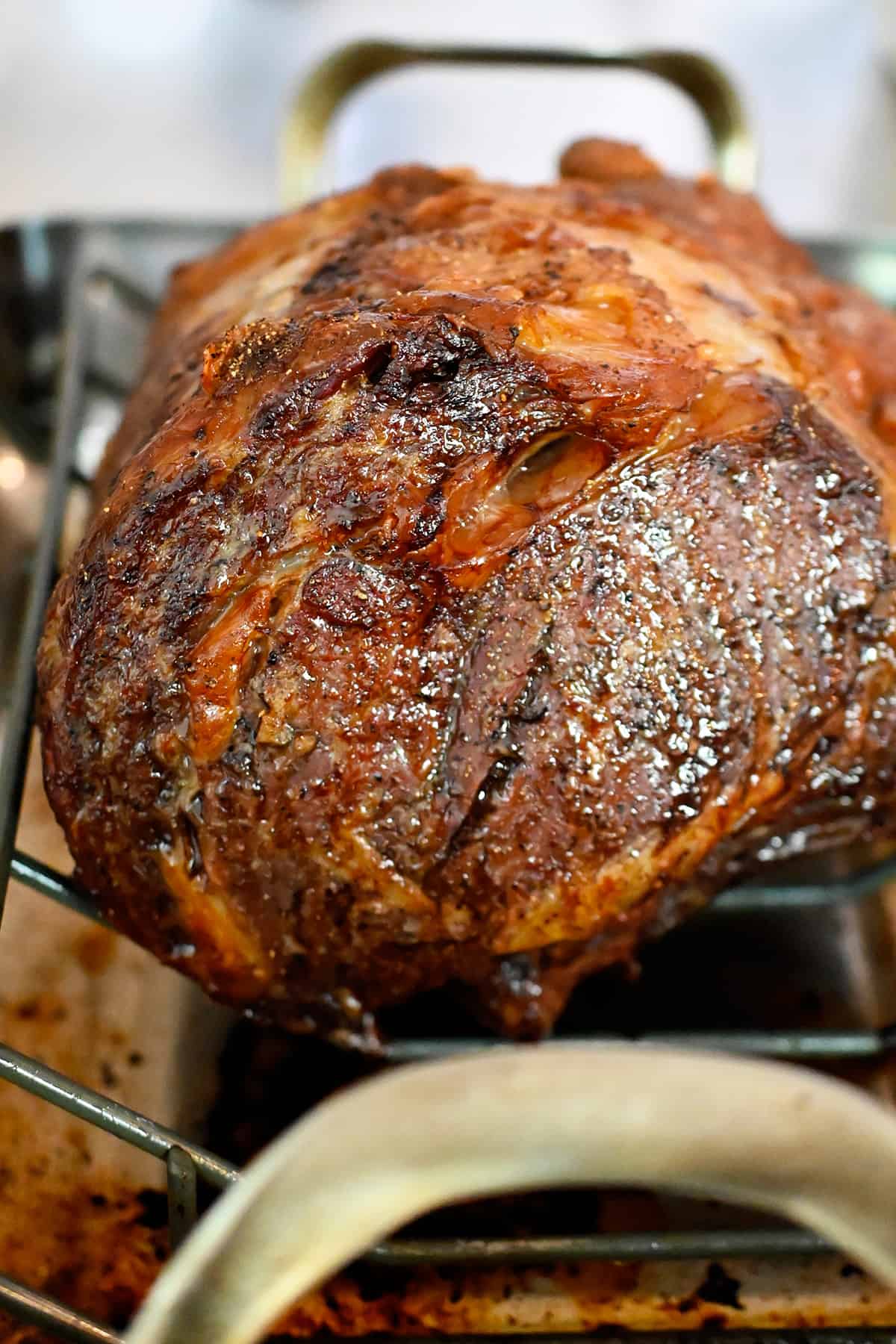
Take the roast out of the oven. Snip off the twine and lift the roast off the bones.

Place the roast on a cutting board, and carve the meat into slices.
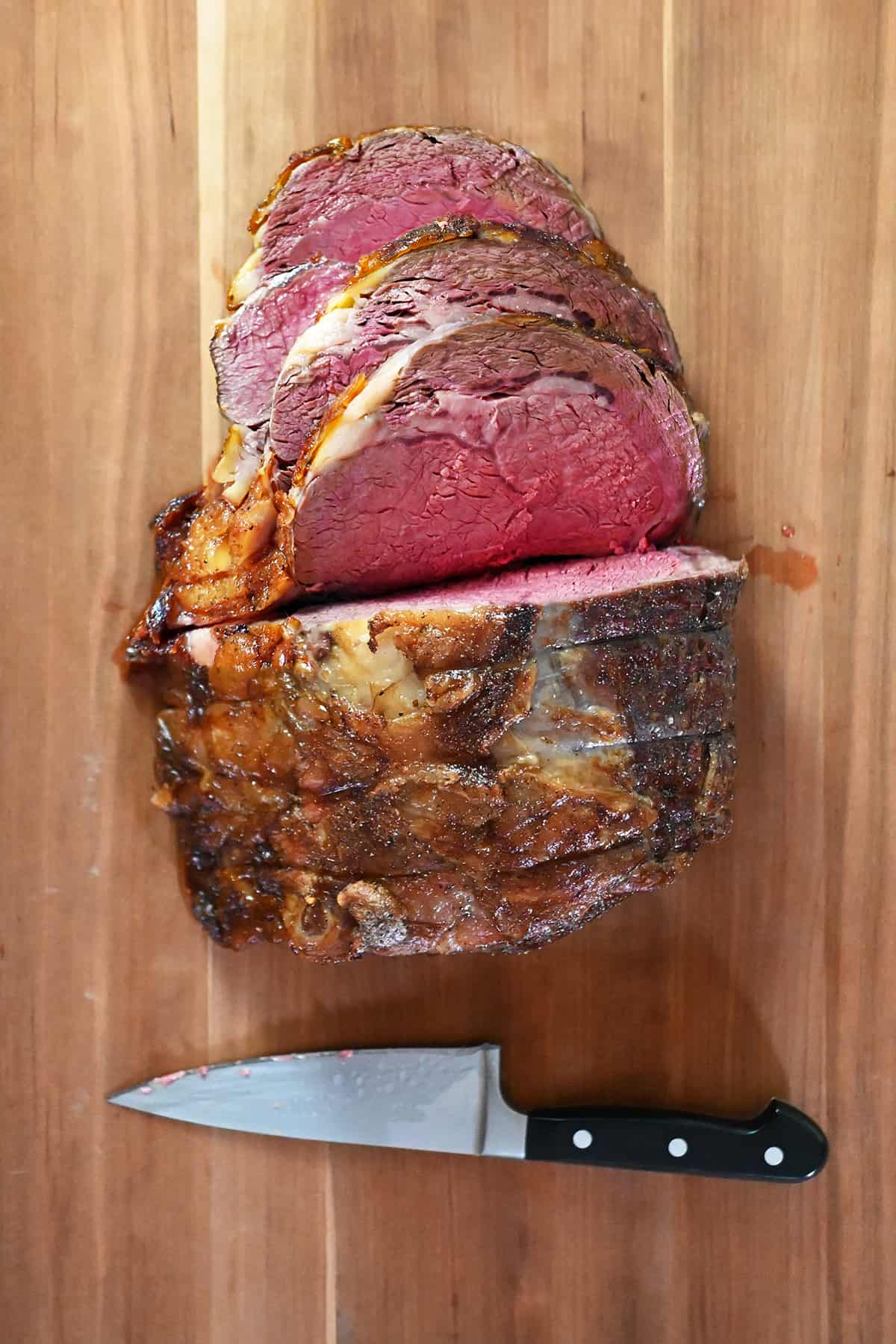
What do you serve with it?
How do you save leftovers?
Leftover prime rib can be stored in an airtight container in the fridge for up to 4 days and in the freezer for up to 4 months. It’s the ultimate emergency protein that can be chopped up and added to soups, sweet potato hash, scrambles, stir-fries, cauliflower fried rice, salads, you name it!
Looking for more recipe ideas? Head on over to my Recipe Index. You’ll also find exclusive recipes and in my cookbooks, Nom Nom Paleo: Food for Humans (Andrews McMeel Publishing 2013), Ready or Not! (Andrews McMeel Publishing 2017), and Nom Nom Paleo: Let’s Go! (Andrews McMeel Publishing 2022).
Prime Rib
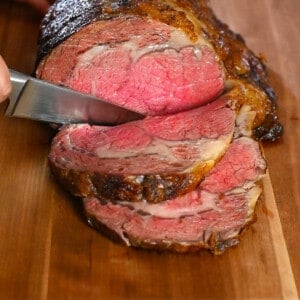
Ingredients
- 9 pound bone-in prime rib roast
- 2½ tablespoons Diamond Crystal kosher salt ~¾ teaspoon salt per pound, okay to be liberal!
- 2 teaspoons freshly ground black pepper or to taste
Instructions
- Using a sharp knife, cut the bones off the rib roast (or better yet, have your butcher do this for you). Set the bones aside.
- In a small bowl, measure out about ¾ teaspoon Diamond Crystal kosher salt per pound of meat, and mix in freshly ground black pepper.
- Sprinkle the salt and pepper mixture on all sides of the now-boneless ribeye roast and the rib rack as well. Season generously, people!
- Place the seasoned roast back on top of the bones, with the fat cap facing up. Tie the bones to the roast with kitchen twine and place the prepared roast in a rimmed baking sheet.
- Leave the roast uncovered in your fridge for at least 1 day and up to 4 days. The pre-salting and air-drying will ensure a delicious roast with a browned, beefy crust.
- Take your meat out of the fridge and keep at room temp for about 3 hours before you plan to cook the prime rib. Place the seasoned rib roast on a greased roasting rack in a roasting tray.
- Heat the oven to 250°F with the rack in the lower middle position.
- Cook for 4 to 5 hours or until the internal temperature in the thickest part of the roast is 125-130°F for medium-rare prime rib, or 135-140°F for medium.
- Take out the roast and tent it with foil. Crank the oven to the highest possible temperature it will accommodate (typically 500-550°F). You can also turn on the broiler. We want it HOT!
- Remove the foil and put the roast back in the oven, and cook for 5-10 minutes or until the exterior is crisp and well-browned (but not burnt!). There's a fine line between browning the exterior and cooking the interior of the prime rib too much!
- Take the roast out of the oven. Snip off the twine and lift the roast off the bones. Place the roast on a cutting board, and carve the meat into slices.
Video
Notes
-
- Get a good meat thermometer! Even though this recipe is easy-peasy and you’re roasting the meat at a low temp for a long time, you do need an accurate meat thermometer to check that the roast is cooked perfectly. I use both an in-oven thermometer so I can monitor the temperature as the roast is cooking and an instant-read thermometer to double-check the temp.
-
- Buy a bone-in, but cut out the bones! This ensures great flavor and ease of slicing because you can season the roast all over and carve it easily when it’s done. You can have your butcher cut out the bones or use a sharp boning knife to remove it yourself.
-
- Season the roast liberally with salt! If you want a well-seasoned and juicy roast, you need to salt it well and dry-brine it for at least 24 hours and up to 4 days. This way the salt will penetrate the meat properly and it will taste amazing!
-
- Take your time! Plan ahead and dry-brine the roast for at least a day and then allot 4 to 5 hours to slow roast the prime rib at 250°F. Low and slow will cook it evenly!
-
- Blast the crust! After the slow roast, blast the roast with a quick hit of heat to brown the crust. I like to err on the side of not browning too much because I want the interior to be the perfect temperature (which in my opinion is medium rare).
Nutrition
Nutrition information is automatically calculated, so should only be used as an approximation.
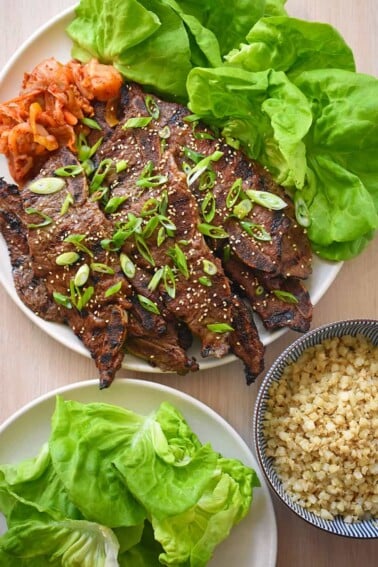
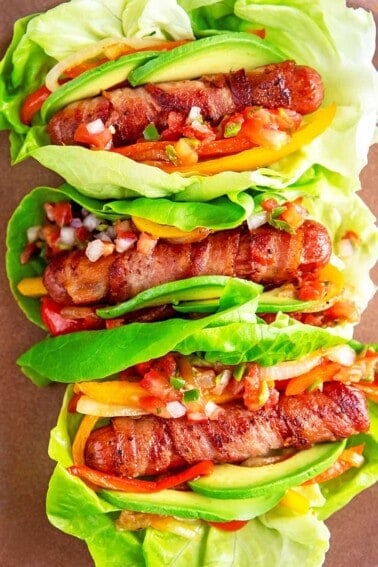


I have a boneless prime rib. Will it work with this recipe?
Thanks
Yes, but you’ll need to monitor the internal temperature more carefully because it can cook faster.
Help! I’m searching everywhere for cooking time for my 11lb roast. Trying to time my cooking and serving time that day and I know this will take a while, but can’t figure out how long. I had been seeing the original Kenji recipe at 200 degrees, but if I opt for your 250, how long do you guesstimate per pound??
I always go by my meat thermometer to check when the roast is finished, but I bet the timing for an 11 pound roast is closer to the 5 hour mark.
Roundabout cooking time for 16 lb roast? Internet says 8 hours 😩 at 250?
I haven’t tried on that big but I bet it would take that long. You can always cut it in half and cook for 4 to 5 hours…
Hey Michelle,
So keen to try this with family this weekend. What would your rough guess for a 4 pound prime rib be? I will have a thermometer, but just trying to plan ahead 😁.
Thanks so much for your help!
Start checking the internal temp at about 1 1/2 hours, cook until the internal temperature in the thickest part of the roast is 125-130°F for medium-rare prime rib, or 135-140°F for medium.
After it reaches the desired temp— how long to you tent it before you put it back in the extra hot oven?
And should it rest for a bit before cutting?
I only tent the roast for as long as it takes the oven to reach the new hot temperature. You don’t really need to rest it for a bit before cutting because it is only under the hot temp for less than 10 minutes. You can rest it if you want, but resting is more important if you are roasting for a longer time at a higher temp.
It was hard to believe that salt and pepper alone could yield such delicious prime rib, but somehow it did! The only thing easier than this recipe was eating the results, I’m already looking forward to the next time I make it.
Do you think it would be okay if the roast tests tented for a couple hours before finishing at high heat just before serving? Would be easier to time dinner if possible. Thanks
I made this recipe for a holiday dinner party with friends and it was super easy and delicious! Everyone loved it!
Hi Michelle! Love your website/book! 🙂 I’m making this for the first time and you mention this:
“Take out the roast and tent it with foil. Crank the oven to the highest possible temperature it will accommodate (typically 500-550°F). You can also turn on the broiler. We want it HOT!”
but I didn’t see anywhere that mentioned when to put the tented roast back into the oven, so I was a little confused there, hope you don’t mind my comment – just wanted to let you know.
Thanks for all the help!! <3
You put the roast back in the oven (without the foil) when the oven has reached 500°to 550°F degrees. My oven takes a few minutes to reach this high temperature from 250°F.
In the picture of removing the roast from the bones, the bones look a bit undercooked. How do you use them and finish cooking them? Thanks
You can cut up the ribs and toss them into a stockpot or Instant Pot to make bone broth or stock. Alternatively, you can cut them up and roast them at 400°F until fully cooked.